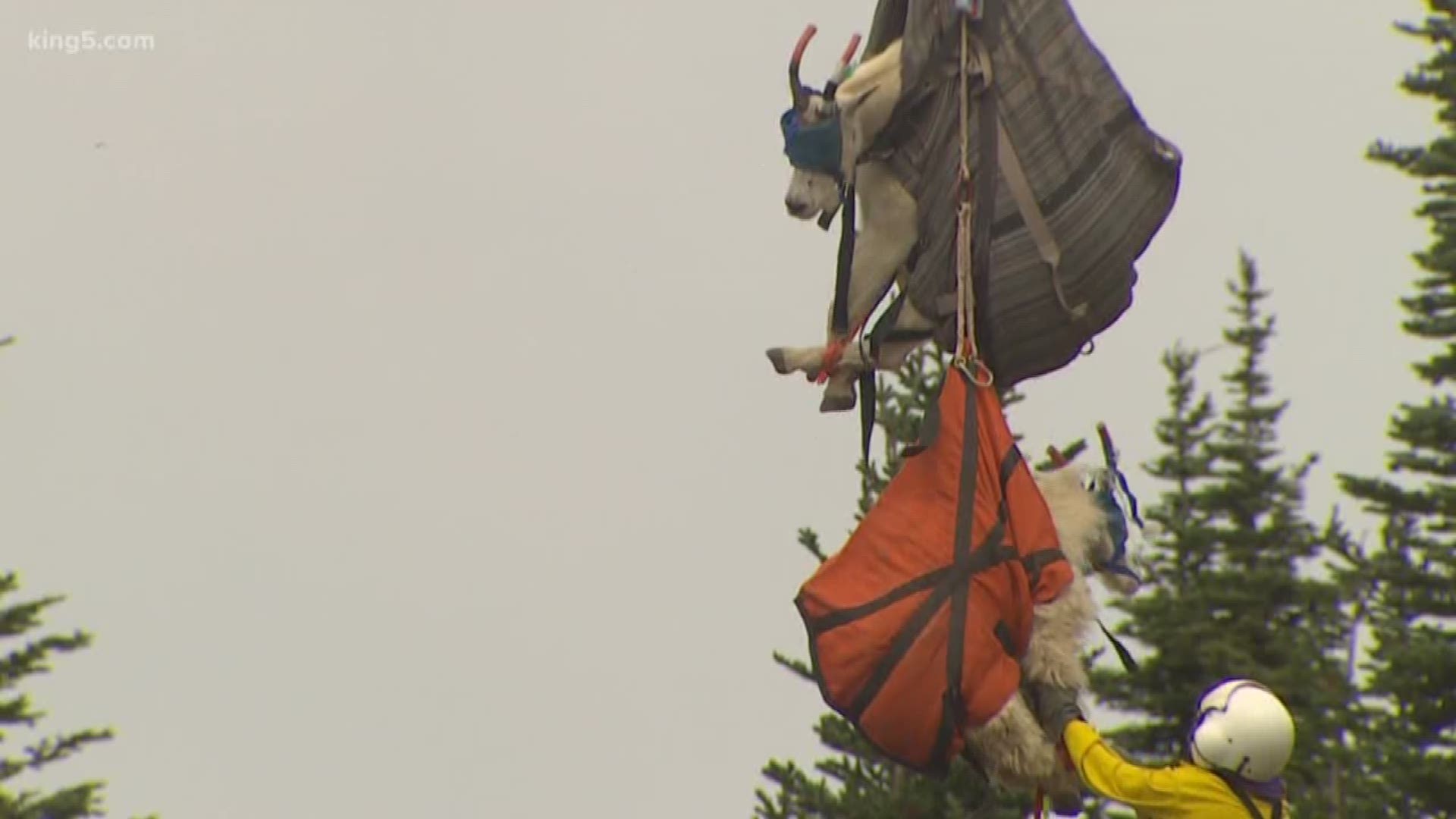PORT ANGELES, Wash. — Officials in Olympic National Park resumed their mission this week of relocating non-native mountain goats back to the Cascades.
The National Park Service says people introduced the goats prior to the park being formed.
“But they love it here, and the population grew from 12 to over 1,000,” said Patti Happe, wildlife branch chief for the park.
The goats threaten native species, she said, and also crave salt. They can get it in the Cascades, but not in the Olympics – which forces them to pursue another source: human urine.
“They will follow you on the trail until you stop and urinate,” Happe said. “Sometimes they’re like, Ok, I’m waiting for you, and follow you down the trail. And people think they’re getting chased, and some goats get aggressive in their seeking of salt.”
In 2010, a hiker was fatally gored by a goat in the park.
Crews began removing the goats in the summer of 2018. Monday, they started another two-week operation working out of two stations – one in the Hurricane Ridge area of the park and another near Hamma Hamma in Olympic National Forest.
The goats will eventually be taken across Puget Sound and into their native range. The Washington Department of Fish and Wildlife plans to release the goats at six sites in the Cascades. They include the Chikamin area in the Okanogan-Wenatchee National Forest, Preacher Mountain in the Mount Baker-Snoqualmie National Forest, Hardscrabble Ridge and mountain peaks south of Darrington.
“Where as we don’t want the goats here because they’re not native, they need them in the Cascades because they have populations that haven’t recovered from historic over-harvest,” Happe said. “So it’s a win-win for everybody.”
State wildlife officials had planned to discuss how the animals would be released during a Monday event near Snoqualmie Pass, but canceled it due to weather.
The goats are darted or netted by a contract crew in a helicopter, then a "mugger" jumps out to secure and calm the animal. Medication is given to reverse the sedative, and the goat is fitted with hobbles, horn protectors, a blindfold, and loaded into a sling for transport.
Several goats can be transported beneath the helicopter at once in a daisy chain. Once they arrive at the processing area, a team examines the animals and loads them into crates for transport.
“It’s all about animal health for us,” said Jenny Powers, a park service wildlife veterinarian.
“One of the challenges is it takes some time to get them out of the field,” she said. “It can take up to an hour under the helicopter and handling, so some of the animals have gotten rather warm while they’re out there.”
When they arrive, she said, they cool the animals if necessary and administer prophylactic drugs and sedatives for the journey ahead.
Officials captured 17 Monday and Tuesday at the start of the two-week goat relocation period, including a kid about 6 weeks old, which got a ride on a mugger's lap inside the helicopter instead of hanging beneath it.
In 2018, 115 goats were removed from the park. Happe described those as "low hanging fruit," and said the issue now is that goats are wising up to the helicopter. Goats that understand what the approaching sound means are proving to be more elusive, she said. They do not expect to reach the 2018 number this year.
“We’ve had a couple of injuries, nothing terrible,” said Powers. “One animal fell down a small hill, got a couple lacerations, but other than that, there haven’t been many complications.”
Goats that can’t be caught will eventually be killed, the park service said. The park service's plan estimates about 50% of the population - approx. 325-375 animals will be captured. Another 40% (275-325 animals) will be lethally removed.
The 10% remaining after initial management will subject to ongoing maintenance, the park service said, prioritizing areas of high visitor use, and large groups likely to grow in number.
“We want to catch as many goats as we safely can,” Happe said. “And we want to give as many to the state as we can, but there’s going to come a time and place where we know the pilot has flown over it, and goats are elusive, and know they can’t catch them. It’s expeditious to do some lethal removal only in those circumstances.”
Happe said the relocated adult animals are surviving at a 70% rate – lower than the normal 90%. Half of the moved kids are surviving, which she said was normal.
A second two-week operation is scheduled for August of this year.
The Associated Press contributed to this report.

